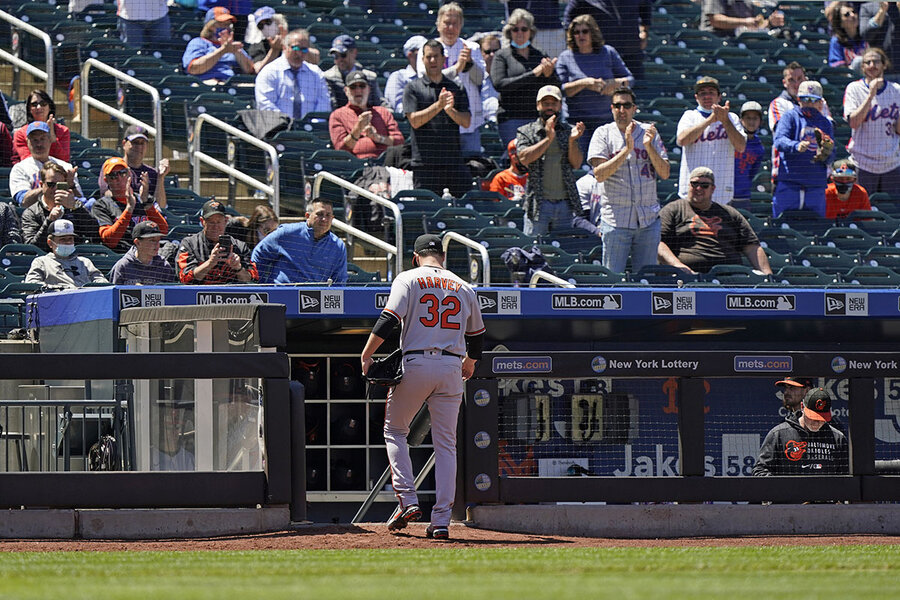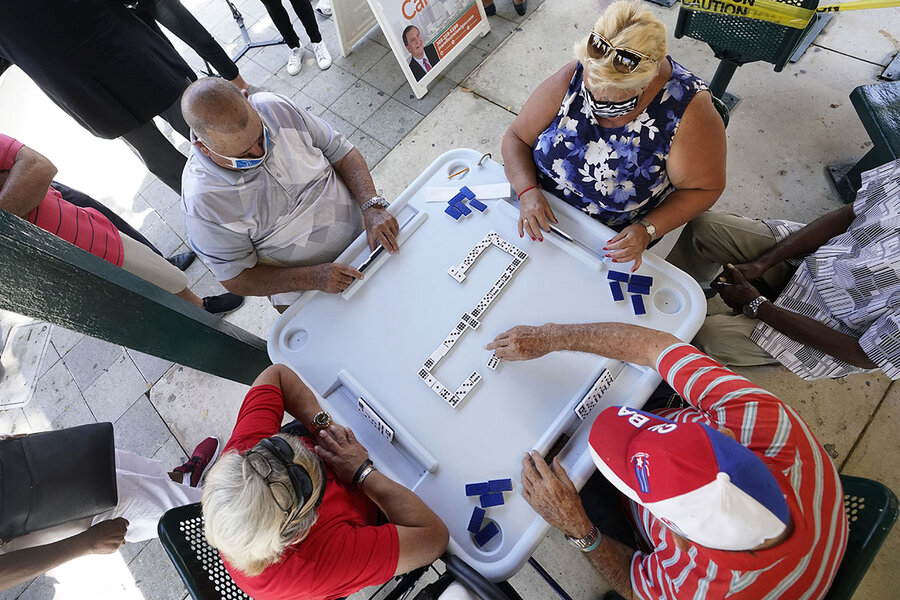In US, pandemic’s end is in sight. Are Americans ready?
Loading...
There’s no playbook for ending a pandemic. The coming months will likely involve a national effort to write one in real time, with approaches that are likely to differ across state, city, or even local lines.
“We haven’t done this for 100 years,” says Georges Benjamin, director of the American Public Health Association. “We’re evolving back to a degree of openness. But we don’t know exactly what that will look like.”
Why We Wrote This
Why does Brookline, Massachusetts, still require masks outdoors, despite CDC guidance? Different people are comfortable with different levels of risk and change, scientists say, urging empathy as U.S. towns unmask at their own pace.
The differences in approach are no longer as stark across red-blue lines either. Florida, Alabama, and Mississippi – which lag in vaccination rates – are reopening their states, but soon New York, New Jersey, and Connecticut will too. And on Thursday, the Centers for Disease Control and Prevention changed its guidance to allow vaccinated Americans to be unmasked indoors in most situations.
Even if people have spent the last year fantasizing about a return to “normal,” disrupting routines now considered commonplace will involve taking away a sense of security for many. Uncertainty is uncomfortable.
“Endings tend to be messy, and they’re not clear cut or neat,” says Steven Taylor, who studies the psychology of pandemics.
Brooke McDonald’s walk to work begins at her dorm on Boston College’s campus. The school maintains specific safety rules for its students, including an outdoor mask mandate. So as she exits, her mask stays on.
But as she rounds Chestnut Hill Reservoir and enters Brighton, those rules expire. Per updated state orders, face coverings are no longer required outdoors in Massachusetts. If she wanted to, Ms. McDonald could doff her mask the rest of the way to Cityside Tavern, where she works as a server.
Walk two more blocks east, though, and the rules change again. Despite CDC guidance, the neighboring town of Brookline chose to maintain its universal mandate. Socially distanced or not, Ms. McDonald would need to mask up once more.
Why We Wrote This
Why does Brookline, Massachusetts, still require masks outdoors, despite CDC guidance? Different people are comfortable with different levels of risk and change, scientists say, urging empathy as U.S. towns unmask at their own pace.
The rules, she says, “kind of [depend] on where you are.”
Ms. McDonald doesn’t mind the area’s mosaic of safety protocols, but she struggles to keep up. With so many rules for so many areas, she tends to just match the behavior of those around her. When in Brookline, do as the Brooklinians do.
Emblematic in her mile-long trip to work are the idiosyncrasies of America’s current phase in the pandemic. Key metrics suggest the country is in the early stages of bidding the health crisis goodbye. Yet with herd immunity out of reach – even in New England, home to the highest vaccination rates in the country – uncertainties remain.
More broadly, there’s no playbook for ending a pandemic. The coming months will likely involve a national effort to write one in real time, with approaches that are likely to differ across state, city, or even local lines.
“We haven’t done this for 100 years,” says Georges Benjamin, director of the American Public Health Association.
“We’re evolving back to a degree of openness,” he says. “But we don’t know exactly what that will look like.”
The differences in approach are no longer as stark across red-blue lines either. Florida, Alabama, and Mississippi – which lag in vaccination rates – are reopening their states, but soon New York, New Jersey, and Connecticut will too. And on Thursday, the Centers for Disease Control and Prevention changed its guidance to allow vaccinated Americans to be unmasked indoors in most situations.
But Dr. Benjamin doesn’t expect the process of moving on to be uniform. There are about 3,000 health departments in the United States, ranging in size from federal to municipal. Laws vary by state, but the system is decentralized, meaning decisions are more often made at the bottom than the top. To wit, CDC releases on COVID-19 come in the form of guidance, not regulations. Unless the issue crosses state lines, states and counties are free to follow that guidance or not.
“Public health is governed at the local level,” says Dr. Benjamin.
For example, after the CDC’s Thursday announcement both Massachusetts and Boston said they would keep local mask restrictions in place, for now.
While that system itself is not flawed, he says, it does involve higher variance. Members of the public who don’t routinely check state and local regulations are bound to get confused, especially with troves of misinformation and scenes of major outbreaks abroad circulating at a fingertip. At once, risks might appear higher or lower than they actually are.
“For the average person, it must be baffling to be constantly hit by shifting standards,” says Steven Taylor, who studies the psychology of pandemics at the University of British Columbia.
Such confusion comes even as the country has made real progress this spring. Since a peak in January, daily cases and deaths have plummeted, returning to rates not seen since last September. The CDC and other forecasters predict even steeper declines in cases and deaths by midsummer.
Yet there’s a continued sense among many that the country isn’t out of the woods, evident in policy and public behavior.
“Most people haven’t changed their precautions all that much since early January,” says Zoë McLaren, an associate professor of public policy at the University of Maryland, Baltimore County, who focuses on infectious disease.
From a pure risk-reward point of view, that consistency may not make sense, but Dr. McLaren says the hesitancy is inevitable. Each time regulations and guidance change, the public takes time to ponder them and decide whether, and how much, to alter their precautions.
“The risk level has come down a ton over the past couple of months, and we know that that means the optimal behavior should also shift quite a lot during that period,” says Dr. McLaren. “Yet we see that the behavior hasn’t shifted.”
Risk tolerance differs by area
Overall, the same is true in terms of policy. Some states have blitzed toward reopening, but most are iteratively relaxing precautions as cases and deaths fall.
“What you’re seeing in terms of [each state’s] governor who’s making decisions is it’s less about political ideology,” says Dr. McLaren. “It’s less about even the specific current vaccination rates, and more about tolerance for risk.”
Dr. Swannie Jett, director of health and human services for Brookline, which kept its outdoor mask mandate indefinitely, says his town has consistently been one of the most cautious in the country throughout the pandemic, including being one of the first areas with a mask mandate. Given Brookline’s tight shopping districts and otherwise crowded restaurants, he says, more conservative rules are appropriate – regardless of national recommendations.
“Throughout the pandemic, CDC has often made changes,” says Dr. Jett. “So I’d rather use a precautionary principle and be safe rather than sorry.”
On the opposite end, policymakers have sometimes relaxed rules before their area feels ready. In late April, Washington Mayor Muriel Bowser widely loosened mask requirements for vaccinated adults, only to reverse the change after public outcry.
Policymakers are left searching for a Goldilocks zone that allows fewer restrictions, while still making sure cases continue to fall and the public feels safe. Different areas have different solutions, and that process requires confronting the same uncertainty present at the pandemic’s beginning, says Dr. Taylor, of the University of British Columbia. Even if people have spent the last year fantasizing about a return to “normal,” disrupting routines now considered commonplace will involve taking away a sense of security for many. Uncertainty is uncomfortable.
“In early 2020 it was the norm not to wear a mask,” says Dr. Taylor. “Now it’s normal to wear masks. So what is normal?”
“Endings tend to be messy”
With that hesitancy in mind, public health officials should approach this phase with empathy, says Dr. McLaren. Some members of the public may be slow to adjust. Even if there are costs to being overly cautious, she says, that’s OK. Transition phases take a while.
“Endings tend to be messy, and they’re not clear cut or neat,” says Dr. Taylor. “They tend to drag out, and then there’s that ambiguity again.”
Facing such ambiguity in Brighton, Ms. McDonald is ready for the pandemic to end. But she’s in no rush. Despite the often contradictory rules around her, she prefers a more careful approach and has felt safe throughout the semester.
Still as restrictions loosen, she says she’ll be ready. She works at a summer camp and hopes to have some mask-free moments. She misses social gatherings and wants a regular year of college.
But until then, she’ll keep watching other people’s behavior on her walks to work. Recently those have involved fewer masked faces. Ms. McDonald doesn’t mind.
“I think the end is in sight, which is exciting,” she says.










